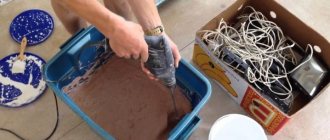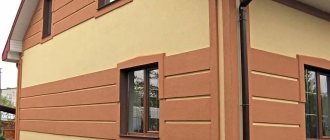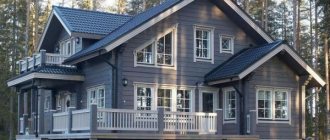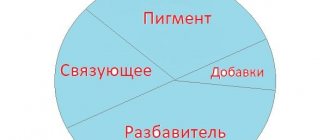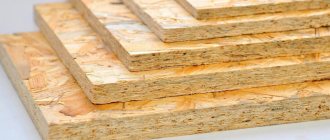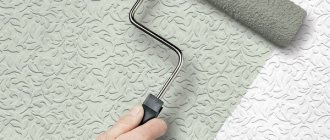Facade paint allows you to quickly and inexpensively refresh the appearance of a building. A popular variety is acrylic paint for exterior use, which has gained recognition due to its practicality and good performance characteristics.
Facade acrylic paints, after drying, form a thin polymer layer that protects the facade from the negative effects of the environment.
Features of facade acrylic paint
Before you paint walls with such compounds, you need to understand what they are. Acrylic paints are made on the basis of appropriate resins. Water is most often used as a solvent, although organic-based varieties are also found.
Theoretically, latex mixtures are also included in this group, since they are acrylic materials, only the composition includes artificial rubber, and the amount of resins is increased. Acrylic mixtures form an elastic, airtight, abrasion-resistant coating.
The advantage of acrylic paint is its versatility. It is used for almost all substrates, except lime plaster and sand-lime brick. This means that it is applied to ceramic bricks, mineral plaster, wood, etc.
At the same time, acrylic compositions are good for old facades, as they help strengthen the base.
Mixtures are recommended for painting walls and ceilings inside a building, but in this case we are talking about an interior variety, which is especially valued for its environmental friendliness.
Acrylic resin is the basis for most façade acrylic paints.
The composition of acrylic paint includes the following components:
- The binder is acrylic resins, which allow the formation of a durable film coating. Acrylic mixture and acrylate, despite similar names, differ in the binder, since the first contains an acrylate-copolymer dispersion with vinyl, latex or styrene, and the second contains resins in their pure form.
- Fillers that are necessary to improve performance (for example, increase the level of water resistance, add a glossy shine or provide a matte texture).
- Auxiliary substances, including various thickeners, stabilizers, defoamers.
Compositions may vary from manufacturer to manufacturer. In addition, within 1 line they produce mixtures that differ in characteristics and purpose.
Advantages and disadvantages
Water-dispersed acrylic mixture has the following advantages:
- upon polymerization, it forms a thin, durable, elastic coating that is resistant to abrasion;
- has a low water absorption rate, which allows you to protect the base material from the negative effects of moisture;
- Available in a wide range of colors;
- easily diluted with water or alcohol;
- forms a coating that can withstand frost;
- dries quickly, which reduces the time required to complete the work;
- has vapor permeability, due to which the material “breathes”;
- retains original color for a long time.
Acrylic paint is used both to protect concrete facades in apartment buildings and to treat the facades of low-rise wooden buildings.
Acrylic paint has disadvantages:
- High price compared to other types of compounds.
- Caution is required when using this type of mixture. The paint layer is applied, after which a break is taken, since there is a risk that it will not dry enough and the paint will not adhere as well. You should wait until it dries completely to understand how necessary another layer is.
You should only buy products from popular manufacturers. Low-quality mixtures can change their shade, even during the drying process.
Read more about the benefits of acrylic-based paints
As a result of painting a wall with acrylic paint, it not only acquires a pleasant color, but is also covered with a polymer film, similar in its characteristics to plastic. This layer creates a strong connection with the wall material, while maintaining elasticity and a number of additional qualities:
A wall coated with acrylic paint takes on a pleasant color and is covered with a polymer film
- Long service life. The paint coating will last for 10 years or more, depending on the composition of the material and the conditions created by the external environment.
- Resistant to moisture penetration, the paint layer is not subject to deformation due to temperature changes. The surface will maintain its ideal appearance regardless of the level of atmospheric humidity.
- Acrylic paint is easy to work with: it dries very quickly, without evaporating toxic compounds, and the paint also has no unpleasant odor. According to experts, this material is best suited for quick and high-quality renovation of a room.
- Variety of colors. Manufacturers offer a wide range of shades of acrylic paints. If desired, you can expand it by using white paint for tinting and selecting the desired shade.
Scope and types of paint
This is an all-season paint that withstands temperature changes and adverse environmental conditions, which has provided a wide range of applications.
The mixture can be applied to any mineral base; it can also be used on wood. Concrete, brick, textured, cement or acrylic plaster are suitable options. Wooden facades, gazebos, and terraces can also be painted with acrylic compounds.
It is believed that it can also be used for metal parts, although this is not the best option for them. It fits worse on acrylic plaster and sand-lime brick, as well as on old coating if it is formed by silicate materials.
In this case, the mixtures allow you to obtain any shades by adding pigment. The material must be diluted and tinted in accordance with the manufacturer's instructions.
Specifications
There are a number of characteristics that are important for external work. They may differ from one manufacturer to another, so you should check all the parameters using the accompanying documentation.
These characteristics include:
- Vapor permeability, that is, the ability to pass steam, preventing the formation of condensation and improving the operating conditions of wall and thermal insulation materials. Some manufacturers indicate the amount of water that penetrates a painted surface of 1 square meter. In this case, the indicator should be no lower than 120 g/sq.m per day. If the coefficient of diffuse properties is specified, it is designated as Sd. Normal vapor permeability in this case is 0.05-0.11 m.
- Water permeability is also considered an important parameter. For facade paint, it is important that the indicator is at a minimum level, otherwise the walls will be damp, fungi and mold may appear on them, and the layer will collapse before plaster. In technical documentation, the indicator is called the water absorption coefficient and is denoted as w. It should be no more than 0.03-0.05 kg/sq.m*h, but the lower the better.
- Resistance to ultraviolet radiation. Sunlight is useful because it prevents the appearance of mildew and mold, but it can destroy even high-quality paint pigments, and sometimes the rays cause the layer to swell or crack. Acrylic compounds have high UV resistance.
- Abrasion resistance. From the outside, the walls of the house become dirty even during normal use; they need to be cleaned periodically, otherwise the paint and plaster layers will be destroyed. This is why abrasion resistance is so important. Manufacturers determine it in laboratory conditions. It reflects the number of cleaning cycles that the coating can withstand. A good indicator is at least 5000 cycles.
- Drying time. Typically, acrylic paint dries within 24 hours, but under favorable conditions this happens even faster, which is important for façade mixtures.
Paint consumption plays an important role. The financial costs of finishing work also depend on it. Acrylic mixture is more expensive than other facade compositions.
24 hours is the time required for most types of façade paints to dry completely.
Features of the material
Before purchasing, you need to study some basic indicators of this composition:
Preparing the surface for painting
The main task of the preparatory stage is to thoroughly clean the surface and ensure good adhesion of the paint to the base.
Preparation procedure:
- Remove all old finishing materials from the surface. If the plaster applied to the ceiling/wall has large flaws, then cleaning must be carried out right down to the base.
- Check the base for defects - bumps, chips, gouges and cracks. Remove the bumps with sandpaper or a spatula, and fill the remaining defects (if they are not significant) with finishing material.
- Large cracks should be expanded and treated with putty. Potholes in the ceiling can be filled with polyurethane foam or reinforcing tape can be used.
- Leave the putty solution until completely dry (about 24 hours).
- Clean the areas treated with putty with sandpaper and remove dust with a brush.
- Before painting, prime the ceiling and walls. Painters recommend using a deep penetration primer - this composition forms a protective film that ensures good adhesion and reduces paint consumption.
For facade work
The mixture for outdoor use from different manufacturers has different characteristics, so it would be advisable to indicate average values. So, on average, the service life of such coating is 7 years.
The drying time of 1 layer on a mineral base is from 30 minutes to 2 hours. Afterwards, you can dilute a new portion of paint and apply the 2nd layer. But complete drying takes longer - up to 24 hours.
As for the artistic effect, acrylic paints can be different, from a deep matte texture to a silky glossy sheen.
The water absorption coefficient of most compositions does not exceed 0.03 kg/sq.m per hour. The average density is 1.3-1.42 kg/l. The operating temperature range of the finished layer is -50…+70°C. In this case, the application temperature varies widely (-20…+30°C).
Polyvinyl acetate paint
Water-based paint of this type is used not only for interior but also for exterior decoration. In addition, the material can be used for processing wooden surfaces, cardboard, plywood and so on. This material is fireproof; prolonged exposure to water can lead to damage to the coating. Drying time at optimal temperature and humidity is 2 hours. The covering power of the material is high, but to cover stains and darker tones you will have to apply 2-3 layers. The material consumption is 200 ml per 1 m2. Due to its relatively high consumption, this material is one of the most expensive in the water-based class.
Polyvinyl acetate paints have an optimal price-quality ratio
When choosing a material, it is important to remember that all the above technical characteristics are inherent only in compositions that are manufactured using the correct technologies. They have nothing to do with handicraft materials
For wooden facades
Universal facade acrylic paint from GOL.
For wooden surfaces, materials with the same characteristics are used as for standard facade work.
But you should pay attention to the fact that to improve adhesion in this case you need to use a primer, preferably acrylic.
At the same time, on a wooden surface, such paints dry longer than indicated - up to 6-8 hours.

